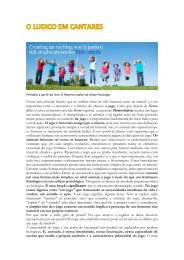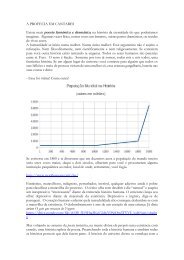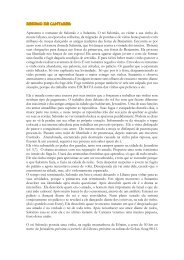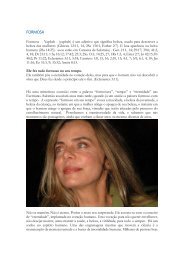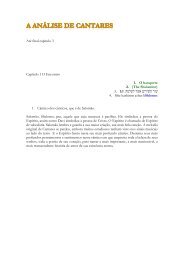Motherhood in Childhood
Create successful ePaper yourself
Turn your PDF publications into a flip-book with our unique Google optimized e-Paper software.
ehaviours of boys and girls, or <strong>in</strong>creas<strong>in</strong>g use of<br />
contraception.<br />
Yet there are many <strong>in</strong>novative <strong>in</strong>itiatives, not<br />
featured <strong>in</strong> this chapter, that aim to reduce the<br />
prevalence of child marriage, keep girls <strong>in</strong> school,<br />
change attitudes about gender roles and gender<br />
equality and <strong>in</strong>crease adolescents’ access to sexual<br />
and reproductive health, <strong>in</strong>clud<strong>in</strong>g contraception,<br />
that have not yet been evaluated but warrant<br />
further study to determ<strong>in</strong>e their effectiveness <strong>in</strong><br />
improv<strong>in</strong>g girls’ lives.<br />
Two important lessons may be drawn from<br />
countries’ experiences described <strong>in</strong> this chapter:<br />
<strong>in</strong>vest<strong>in</strong>g <strong>in</strong> girls empowers them <strong>in</strong> many ways,<br />
<strong>in</strong>clud<strong>in</strong>g enabl<strong>in</strong>g them to prevent pregnancy;<br />
and dismantl<strong>in</strong>g the barriers to girls’ enjoyment of<br />
their rights and address<strong>in</strong>g the underly<strong>in</strong>g causes<br />
of adolescent pregnancy can positively transform<br />
girls’ lives and futures.<br />
The most vulnerable girls, <strong>in</strong>clud<strong>in</strong>g those who<br />
are extremely poor, ethnic m<strong>in</strong>orities or from<br />
<strong>in</strong>digenous populations, and very young adolescents<br />
who have been forced <strong>in</strong>to marriage,<br />
require additional support but are often left out<br />
of development or sexual and reproductive health<br />
programmes. In most cases, contextual data and<br />
<strong>in</strong>formation about these girls are scarce or<br />
non-existent, and little is known about their vulnerabilities<br />
and challenges, so it is not surpris<strong>in</strong>g<br />
that few governments or civil society organizations<br />
have formulated policies, programmes or laws that<br />
can protect or empower them.<br />
A grow<strong>in</strong>g number of governments are <strong>in</strong>vest<strong>in</strong>g<br />
<strong>in</strong> adolescents <strong>in</strong> ways that empower them to<br />
prevent a pregnancy, but fewer have <strong>in</strong>vested <strong>in</strong><br />
systems and services that support a girl who has<br />
become pregnant or who has had a child and that<br />
can help protect her health and the health of her<br />
child and help her realize her potential <strong>in</strong> life.<br />
TOWARDS A NEW BEGINNING IN THE PHILIPPINES<br />
Before Geah became pregnant at 17, she considered herself a typical<br />
teenage girl who would hang out with friends and boyfriend, aga<strong>in</strong>st<br />
the wishes of her parents who thought she should stay home, focus on<br />
her studies and f<strong>in</strong>ish school.<br />
Though her pregnancy was unexpected, she said, she was excited<br />
and happy to know that soon she would have a baby, just like some<br />
of her friends did. Her boyfriend was happy about it too, but because<br />
he did not have a job and depended on his parents, he could not offer<br />
much help to her.<br />
One day, Geah went to a health centre <strong>in</strong> Bago for a check-up. One of<br />
the workers there knew Geah and <strong>in</strong>formed her mother, who was furious<br />
when she found out about the pregnancy but nevertheless promised to<br />
support her and took her regularly to a cl<strong>in</strong>ic for antenatal care.<br />
Dur<strong>in</strong>g the pregnancy, Geah rema<strong>in</strong>ed <strong>in</strong> school but dropped out<br />
after giv<strong>in</strong>g birth.<br />
Several months later, she and her parents and younger brother were<br />
<strong>in</strong>vited to participate <strong>in</strong> a course to teach parents and family members<br />
about adolescent health and development, to equip them with<br />
knowledge and skills to understand the challenges faced by adolescent<br />
mothers and to help them cope with the stressors. The course was<br />
hosted by the Salas Youth ACCESS Center, established by the City<br />
Government of Bago through the City Population Office <strong>in</strong> partnership<br />
with Rafael Salas Foundation and with fund<strong>in</strong>g assistance from UNFPA<br />
<strong>in</strong> the Philipp<strong>in</strong>es.<br />
ACCESS is staffed by tra<strong>in</strong>ed youth peer counsellors and caters to<br />
the needs of both <strong>in</strong>-school and out-of-school youth.<br />
Geah said that after the tra<strong>in</strong><strong>in</strong>g, her parents understood her situation<br />
better and gave her more support and encouragement. The l<strong>in</strong>es of<br />
communication with her parents also improved, she said.<br />
Support from her parents and ACCESS enabled her to return to school.<br />
ACCESS also provided contraceptives to help her delay her next pregnancy<br />
until after she completes her education, which she says will help her<br />
get a good job and make enough money to provide for her family.<br />
—Angie Tanong, Commission on Population<br />
THE STATE OF WORLD POPULATION 2013<br />
81








